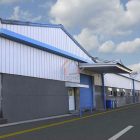How to build sewage treatment factory with steel structures?
Sewage treatment is an essential process for protecting the environment and public health. Steel structure sewage treatment factory is becoming increasingly popular due to their durability, flexibility, and cost-effectiveness. In this article, we will discuss the steps involved in building sewage treatment factory with steel structures.
1. Site selection
The first step in building a sewage treatment factory is to select a suitable site. The site should be located away from residential areas, water sources, and other sensitive areas. The site should also be large enough to accommodate the treatment plant and its associated facilities.
2. Design and planning
Once the site is selected, the next step is to design the treatment factory. The design should take into account the expected flow rate, the type of sewage to be treated, the treatment process, and the final disposal method. The design should also comply with local regulations and environmental standards.
3. Foundation construction
The foundation is a critical component of any steel structure factory. The foundation must be strong enough to support the weight of the sewage treatment factory and its equipment. The foundation should also be designed to withstand the forces of nature, such as earthquakes and floods.

4. Steel structure construction
The steel structure is the backbone of the sewage treatment factory. Steel is a durable and flexible material that can withstand the harsh environment of a treatment plant. The steel structures should be designed and fabricated according to the design specifications and local standards.
5. Equipment installation
Once the steel structure is in place, the next step is to install the treatment equipment. The equipment can be pre-fabricated or assembled on-site. The equipment should be installed according to the design specifications and manufacturer’s instructions.
6. Piping and electrical installation
The piping and electrical systems are essential components of a treatment factory. The piping system should be designed to carry the sewage through the treatment process and to the final disposal method. The electrical system should be designed to provide power to the treatment equipment and control systems.
7. Testing and commissioning
After the installation is complete, the treatment factory should be tested to ensure that it is functioning correctly. The testing should include flow rate, water quality, and equipment performance. Once the testing is complete, the treatment plant can be commissioned and put into operation.
In conclusion, building a steel structure sewage treatment factory requires careful planning, design, and construction. The treatment factory must comply with local regulations and environmental standards. The steel structure should be designed and fabricated to withstand the harsh environment of a treatment plant. The treatment equipment, piping, and electrical systems should be installed according to the design specifications and manufacturer’s instructions. Once the sewage treatment factory is tested and commissioned, it can provide clean and safe water for the community.












